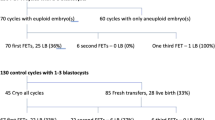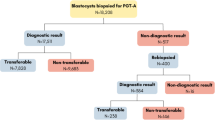Abstract
Purpose
To determine if embryo banking with PGS is more optimal than proceeding with PGS regardless of embryo number.
Methods
Patients were divided into 2 groups, group 1 were those that banked embryos and proceeded through another round of IVF prior to PGS, and group 2 underwent PGS regardless of embryo number. Group 2 was divided into group 2A (patients with >10 embryos) and group 2B (patients who had <10 embryos).
Results
There was no difference in embryos biopsied, normal embryos, number transferred, and pregnancy rate between group 1 and 2. A significant number of patients did not have a transfer in group 2B (6/11) compared to group 1 (3/19) (P = 0.0419). There was no significance between pregnancy rates per transfer between group 1 (6/16) and group 2B (2/5).
Conclusion
Our data suggests that banking will increase the odds of going to transfer but there was no increase in pregnancy rates.
Similar content being viewed by others

References
Verlinsky Y, Cieslak J, Freidine M, Ivakhnenko V, Wolf G, Kovalinskaya L, et al. Pregnancies following pre-conception diagnosis of common aneuploidies by fluorescence in situ hybridization. Hum Reprod. 1995;10:1923–7.
Magli MC, Gianaroli L, Munne S, Ferraretti AP. Incidence of chromosomal abnormalities from a morphologically normal cohort of embryos in poor prognosis patients. J Assist Reprod Genet. 1998;15:297–301.
Munne S, Sandalinas M, Escudero T, Marquez C, Cohen J. Chromosome mosaicism in cleavage-stage human embryos: evidence of a maternal age effect. Reprod Biomed Online. 2002;4:19–28.
Munne S, Chen S, Colls P, Garrisi J, Zheng X, Cekleniak N, et al. Maternal age, morphology, development and chromosome abnormalities in over 6000 cleavage-stage embryos. Reprod Biomed Online. 2007;14:628–34.
Mastenbroek S, Twisk M, Van Echten-Arends J, Sikkema-Raddatz B, Korevaar JC, Verhoeve HR, et al. In vitro fertilization with preimplantation genetic screening. New Engl J Med. 2007;357:9–17.
Staessen C, Platteau P, Van Assche E, Michiels A, Tournaye H, Camus M, et al. Comparison of blastocyst transfer with or without preimplantation genetic diagnosis for aneuploidy screening in couples with advanced maternal age: a prospective randomized control trial. Hum Reprod. 2004;19:2849–58.
Practice Committee of Society for Assisted Reproductive Technology, Practice Committee of American Society for Reproductive Medicine. Preimplantation genetic testing: a practice committee opinion. Fertil Steril. 2008;90:S136–43.
Gianaroli L, Magli C, Ferraretti AP, Munne S. Preimplantation diagnosis for aneuploidies in patients undergoing in vitro fertilization with a poor prognosis: identification of the categories for which it should be proposed. Fertil Steril. 1999;72:837–44.
Gianaroli L, Magli MC, Ferraretti AP, Tabanelli C, Trombetta C, Boudjema E. The role of preimplantation diagnosis for aneuploidies. Reprod Biomed Online. 2002;4:31–6.
Munne S, Escurdero T, Colls P, Xuezhong Z, Oter M, Garrisi M, et al. Predictability of preimplantation genetic diagnosis of aneuploidy and translocations on prospective attempts. Reprod Biomed Online. 2004;9:645–51.
Platteau P, Staessen C, Michiels A, Steirteghem AV, Liebaers I, Devroey P. Preimplantation genetic diagnosis for aneuploidy screening in women older than 37 years. Fertil Steril. 2005;84:319–24.
Taylor TH, Wright G, Jones-Colon S, Mitchell-Leef D, Kort HI, Nagy ZP. Comparison of ICSI and conventional IVF in patients with increased oocyte immaturity. Reprod Biomed Online. 2008;17:46–52.
Leibo SP. A one-step method for direct nonsurgical transfer of frozen-thawed bovine embryos. Theriogenology. 1984;21:767–90.
Edirisinghe R, Jemmott R, Allan J. Comparison of growth rates of fresh and frozen-thawed embryos according to chromosomal status. J Assist Reprod Genet. 2005;22:295–300.
Karlstrom PO, Bergh T, Forsberg AS, Sandkvist U, Wikland M. Prognostic factors for the success rate of embryo freezing. Hum Reprod. 1997;12:1263–6.
Iwarsson E, Lundqvist M, Inzuna J, Ahrlund-Richter L, Sjoblom P, Lundkvist O, et al. A high degree of aneuploidy in frozen-thawed human preimplantation embryos. Hum Genet. 1999;104:376–82.
Taylor TH, Hallowell SV, Phillips M, Orris JJ, Glassner MJ, Wininger JD. Comparison of 9 probe and 12 probe fluorescence in-situ hybridization. Fertil Steril. 2008;90:S490.
Munne S, Sandalinas M, Escudero T, Velilla E, Walmsley R, Sadowy S, et al. Improved implantation after preimplantation genetic diagnosis of aneuploidy. Reprod Biomed Online. 2003;7:91–7.
Ferraretti AP, Magli MC, Kopcow L, Gianaroli L. Prognostic role of preimplantation genetic diagnosis for aneuploidy in assisted reproductive technology outcome. Hum Reprod. 2004;19:694–9.
Author information
Authors and Affiliations
Corresponding author
Additional information
Capsule
Banking embryos prior to PGS increases number of embryos to test and number normal in poor responders, but does not increase pregnancy rates.
Rights and permissions
About this article
Cite this article
Orris, J.J., Taylor, T.H., Gilchrist, J.W. et al. The utility of embryo banking in order to increase the number of embryos available for preimplantation genetic screening in advanced maternal age patients. J Assist Reprod Genet 27, 729–733 (2010). https://doi.org/10.1007/s10815-010-9474-8
Received:
Accepted:
Published:
Issue Date:
DOI: https://doi.org/10.1007/s10815-010-9474-8



